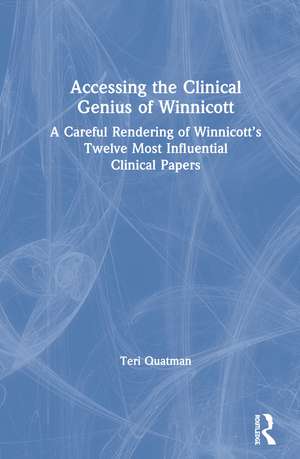Accessing the Clinical Genius of Winnicott: A Careful Rendering of Winnicott’s Twelve Most Influential Clinical papers
Autor Teri Quatmanen Limba Engleză Hardback – 29 apr 2020
Winnicott’s works have been highly valued in the decades since they were first published, and are still relevant today. Winnicott’s writings on the goals and techniques of psychodynamic psychotherapy have been foundational, in that he recast Freudian- and Kleinian-infl uenced thinking in the direction of the more relational schools of psychotherapy that define current 21st-century psychodynamic practice. Winnicott’s writings help us to understand the maturational processes of children, certainly. But more than that, they help us to understand how best to intervene when the enterprise of childhood leads to compromises of psychological health in later years. Yet, despite Winnicott’s influence and continuing relevance, his writings, while at some level simple, are elusive to modern readers. For one thing, he writes in the psychoanalytic genre of the 1930s-1960s, whose underlying theoretical assumptions and vocabulary are obscure in the present day and, for another, his writing often reflects primary process thinking, which is suggestive, but not declarative. In this work, Teri Quatman provides explanations and insight, in an interlocution with Winnicott’s most significant papers, exploring both his language and concepts, and enabling the clinician to emerge with a deep and reflective understanding of his thoughts, perspectives, and techniques.
Engaging and accessible, Accessing the Clinical Genius of Winnicott will be of great use to anyone encountering Winnicott for the first time, particularly in psychodynamic psychotherapeutic training, and in the teaching of relational psychotherapies.
| Toate formatele și edițiile | Preț | Express |
|---|---|---|
| Paperback (1) | 161.18 lei 22-36 zile | +13.58 lei 5-11 zile |
| Taylor & Francis – 29 apr 2020 | 161.18 lei 22-36 zile | +13.58 lei 5-11 zile |
| Hardback (1) | 1098.46 lei 43-57 zile | |
| Taylor & Francis – 29 apr 2020 | 1098.46 lei 43-57 zile |
Preț: 1098.46 lei
Preț vechi: 1156.27 lei
-5% Nou
Puncte Express: 1648
Preț estimativ în valută:
210.21€ • 218.13$ • 175.70£
210.21€ • 218.13$ • 175.70£
Carte tipărită la comandă
Livrare economică 17-31 martie
Preluare comenzi: 021 569.72.76
Specificații
ISBN-13: 9780367859268
ISBN-10: 0367859262
Pagini: 260
Ilustrații: 1
Dimensiuni: 156 x 234 x 16 mm
Greutate: 0.52 kg
Ediția:1
Editura: Taylor & Francis
Colecția Routledge
Locul publicării:Oxford, United Kingdom
ISBN-10: 0367859262
Pagini: 260
Ilustrații: 1
Dimensiuni: 156 x 234 x 16 mm
Greutate: 0.52 kg
Ediția:1
Editura: Taylor & Francis
Colecția Routledge
Locul publicării:Oxford, United Kingdom
Public țintă
Postgraduate, Professional, Professional Practice & Development, and Undergraduate AdvancedCuprins
1. Mind and its Relation to the Psyche-Soma [1949] 2. Primitive Emotional Development [1945] 3. Hate in the Counter-Transference [1949] 4. Transitional Objects and Transitional Phenomena: A Study of the First Not-Me Possession [1953] 5. The Antisocial Tendency [1956] 6. Primary Maternal Preoccupation [1956] 7. Ego Distortion in Terms of True and False Self [1960] 8. The Aims of Psycho-Analytical Treatment [1962] 9. Notes on Ego Integration in Child Development [1962] 10. Mirror-role of Mother and Family in Child Development [1967] 11. The Use of an Object [1969] 12. Fear of Breakdown [1974]
Notă biografică
Teri Quatman is an Associate Professor of Counseling Psychology in the Graduate Department of Counseling Psychology at Santa Clara University, California, USA. She earned her Ph.D. from Stanford University in 1990, and has studied, practiced, and taught psychodynamic psychotherapy to graduate students for the past 28 years. She has also maintained a private psychotherapy practice from 1992 to the present.
Descriere
Donald Winnicott, psychoanalyst and pediatrician, is viewed by many in the psychodynamic field as the "other genius" in the history of psychodynamic theory and practice, along with Freud. This book selects and explores twelve of his most influential, clinical papers.
